In January, Merrill Lynch released the results of a survey
asking baby boomers with $250,000+ in investable assets about their
retirement hopes.
In January, Merrill Lynch released the results of a survey asking baby boomers with $250,000+ in investable assets about their retirement hopes.
There were some interesting across-the-board findings – 70 percent of those polled expected to work at least part-time, and 84 percent felt their retirements would be more comfortable and dynamic than those of their parents. Yet it was the collective response of women in the 1,000-investor study that drew the most attention.
Women envision a very active retirement. Volunteering and travel registered as major priorities for women, more so than for men: 64 percent of women said they wanted to get more involved in their communities, 62 percent planned to devote more time to philanthropy, and 86 percent planned to travel when retired.
Additionally, 14 percent of the women surveyed said that they wanted to start a business after their careers ended.
Women are more concerned than men about running out of money. While 52 percent of male respondents were unsure that their retirement assets would last a lifetime, 63 percent of women polled were worried about outliving their money. Additionally, 70 percent of the women surveyed said they worried about rising healthcare costs.
Will reality prove disappointing? Too many women approach retirement unprepared, with too little saved or invested. You can cite two major reasons for that.
n The multiyear absence of some women from the workplace (which can coincide with peak earning years, lessening the rate of retirement plan contributions).
n A notable earnings gap (full-time working women earn 78 cents for every dollar men earn, which may reflect everything from gender inequality in career paths to wage discrimination).
Another factor may be conservative investing. While you can take on too much risk in your portfolio and pay the price, there may also be a cost for assuming too little risk – your portfolio may not be able to produce returns that keep up with inflation. The federal Consumer Price Index from June 2011 shows annualized inflation at 3.6 percent.
How are you investing and saving to pursue your retirement dream? Is there a strategy in place with realistic objectives? A chat with a financial professional may lead to the discovery of creative new ways to pursue your retirement ambitions.










